Vol 8 No 1 2023 – 3

Traditional agricultural knowledge of banana, cocoa and sugar cane crops as a basis for the sustainable development of the rural parish Mariscal Sucre
1 Tecnológico Universitario ARGOS. Guayaquil. Ecuador; yitzaklozano121@gmail.com.
2 Universidad Estatal de Milagro Guayaquil. Ecuador;; emendozah@unemi.edu.ec.
3 Universidad Estatal de Milagro Guayaquil. Ecuador;; clazov@unemi.edu.ec.
* Correspondence: yitzaklozano121@gmail.com.; Tel.: 0989999197
Available from:http://dx.doi.org/10.21931/RB/2023.08.01.3
ABSTRACT
The research aimed to demonstrate the impact of traditional agricultural knowledge on the sustainable development of banana, cocoa and sugar cane crops in the rural parish of Mariscal Sucre. For this, it was necessary to investigate and adopt a methodology that would estimate the degree of sustainability of the productive systems, identify how it is related to the applied practices and propose an agro-ecological management strategy for these crops. The evaluation was carried out using the MESMIS method but modified through a 30-item form applied to 61 farmers, which collected information to diagnose the incidence of agro-ecological practices and the degree of sustainability of crops. The results were processed in Excel and SPSS and presented with tables and graphs. The agricultural systems showed poor performance, falling into the category of agro-ecological unsustainability. At the same time, the most frequent customary practices consisted of the application of Mulch, and knowledge about protective and antagonistic crops.
Consequently, it was determined that there is a moderately positive correlation between agro-ecological practices and sustainability with a Spearman’s Rho coefficient of 0.48; therefore, the management proposal was aimed at reinforcing the productive component with agro-ecological practices. In conclusion, the customary practices contributed to the parish’s sustainable development. Therefore, it is advisable to give technical training on the implementation of integrated farms and carry out campaigns to rescue traditional agricultural knowledge.
Keywords: Agroecology, customary practices, sustainability assessment, agro-ecological management.
INTRODUCTION
The agroecosystems in a geographic area represent an indicator of great importance, which through the diversity of its components, allow the socioeconomic development of the population. Individuals, in turn, take advantage of the resources that nature provides them to obtain economic income; in exchange for these benefits, the required inputs are returned to the ecosystem so as not to destroy the ecosystem and maintain that harmonious balance between man and nature. 1
It is essential to incorporate various elements such as plants, animals and human beings to consider this ecosystem an agroecosystem. In other words, the richness of its components determines the level of development of the agroecosystem and, in turn, allows the establishment of the level of sustainability that it presents intrinsically for its constant evolution. 2
In contrast, conventional agriculture uses large chemical products, such as fertilizers and pesticides. Pesticides directly affect microfauna, endangering bees, the main insect of interest to agriculture worldwide. Fertilizers contribute to soil salinization and contamination of aquifers.2
It is important to note that agroecology promotes the biodiversity of living microorganisms. Creating a suitable habitat for the optimal development of crops allows local production to be maximized. This contributes by generating more excellent resistance to pests and diseases; In addition, the decrease in the use of agrochemicals will enable pests not to create resistance to the use of these products.4
To support this research, the following question must be answered: Can traditional agricultural knowledge practices in agroecosystems be implemented in the rural parish of Mariscal Sucre, and what degree of incidence will they have based on previous scientific research?
As can be seen, it is urgent to answer this question as it is the best path to take to ensure food sovereignty and guarantee the balance of the ecosystem. Avoiding also the continuous deterioration of the environment is the main problem facing humanity today. This puts at risk the food resources of current and future generations and the existence of the human species on the face of the Earth.
The research aims to support the importance of traditional agricultural knowledge practices in the sustainable development of the banana, cocoa and sugar cane production systems of the Mariscal Sucre parish. Through the application of quantitative and statistical evaluation models, to diagnose the state of sustainability of crops, identify the main areas of intervention, and design proposals for agro-ecological management of these crops.
Much of the research focuses mainly on agro-ecological sustainability from a theoretical point of view, dealing primarily with the production system, leaving a little aside from the social component and especially the knowledge of traditional agriculture. Therefore, the present investigation proposes to identify how these practices are related to the sustainable development of agricultural systems.
Ultimately, the research aims to design a proposal for the agro-ecological management of banana, cocoa and sugar cane crops in the Mariscal Sucre parish. For this, it is necessary to carry out a bibliographic review of sustainability assessment methodologies to choose the most appropriate methods and adapt them to local needs.
MATERIALS AND METHODS
This research has a mixed approach (quantitative and qualitative). The non-experimental – cross-sectional quantitative system will allow us to quantify-measure the frequency and percentage with which traditional agricultural knowledge practices are carried out. The qualitative approach will allow us to lay the scientific foundations through the analysis of scientific documents and the writing of ideas and concepts based on the subject of study. In addition, it will allow the use of an ethnographic design to evaluate the practices of traditional agricultural knowledge existing in the sector under study.
For the field exploration, the simple random sampling method was applied, which allows any member of the population to have the same probability of being chosen; however, because there is no exact record of the number of farmers in the sector. The study population was estimated based on data from the 2010 Population and Housing Census of the INEC, found in the Territorial Development and Planning Plan of the Autonomous Decentralized Parochial Government of Mariscal Sucre, where it is indicated that the Economically Active Population (PEA ) employed that is dedicated to activities in the primary sector, corresponds to 67.48% of the PEA, which is equivalent to 1,359 people; distributed in 74.73% (1242) and 32.24% (117) male and female, respectively.
In addition, a mixed survey composed of 30 items was applied, structured in 4 sections, distributed in: classification data, economic dimension, the social dimension and environmental dimension. To evaluate the sustainability of the agricultural production systems of the parish, the MESMIS methodology was applied, which was adapted with the color classification criteria of REDAGRES, and other particular considerations of the present study; for its adequacy, a bibliographic review was carried out on the evaluation of the sustainability of agroecosystems in Latin American countries, obtaining a total of 20 indicators that correspond to the seven attributes (productivity, stability, resilience reliability, equity, adaptability and self-management) and the three dimension (economic, social and environmental) of agro-ecological development proposed in the MESMIS method. 5
RESULTS
Agroecosystems are systems of production and self-sufficiency of agricultural and livestock products, which humans have designed with a biomimetic approach, which proposes to revolutionize conventional agriculture by combining it with ancestral agricultural practices that imitate the behavior of natural ecosystems, maintaining a high degree of biodiversity and recycling of nutrients, water and other materials. 6
The agro-ecological paradigm integrates the concepts of stability, resilience, adaptability and self-sufficiency of ecosystems to ensure farmers’ livelihood and quality of life. According to Cevallos and his research, a holistic perspective should be considered regarding the biota, its productivity and the environment; In other words, production systems must be implemented that integrate the human, environmental and economic components with a sustainability approach. 7
Given the need for tools to quantitatively assess the sustainability of agroecosystems, experts have developed four methodological frameworks: Temporal trend, resilience and sensitivity, simulation and sustainability indicators. The latter is the most used due to its ease and versatility of operation and consists of using indicators to estimate the changes and trends of the variables, which intervene in the «improvement or degradation of economic, social and environmental conditions.» 8
Practices of traditional agricultural knowledge possessed by farmers of the Mariscal Sucre rural parish.
The study of the demographic characteristics and traditional agricultural practices commonly applied in the Mariscal Sucre parish was carried out by applying a survey to a sample of 61 farmers. Next, the main findings are explained through frequency tables, cross tables and simple and grouped bar diagrams.

Table 1. Frequency and percentages of gender (Source: Own elaboration)
Of the 61 respondents, 59, which corresponded to 96.7%, were male, while only 2, that is, 3.3%, were female. The findings were consistent with the assignment of tasks that rural families usually maintain. The coast, where the field activities are mainly carried out by men, while those of the home is assigned to women.

Table 2. Frequencies and percentages of the level of education compared to age (Source: Own elaboration)
It was recorded that 75.4% of the farmers were adults aged 30 to 45 years, 19.7% of young people aged 18 to 29 years, and a small proportion of older people, whose percentage was 4.9%. In addition, most respondents recorded their schooling level as secondary, except for the elderly, where primary education was more frequent than secondary, with 3.28 and 1.64%, respectively.

Table 3. Frequency and percentages of the ethnic group (Source: Own elaboration)
Of the five ethnic groups that were raised in the form, the respondents only identified themselves as mestizos and montuvios, with 90.2 and 9.8%, respectively. Under this precedent, the categories of this variable could be reduced in the future.

Table 4. Frequency and percentages of land ownership (Source: Own elaboration)
The land is generally provided for services, and almost all of the respondents selected this option, in fact, only two people indicated that the land was their property.
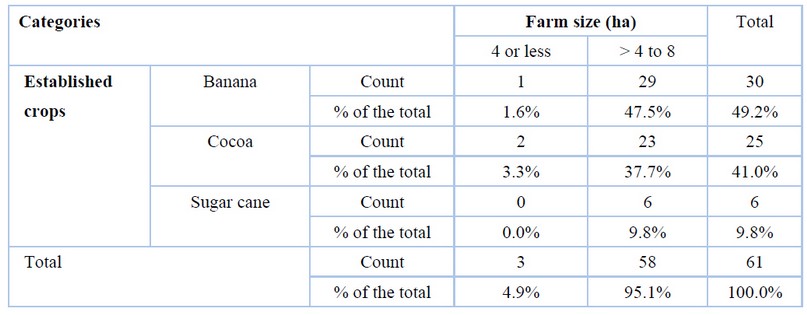
Table 5. Frequency and percentages of crops established by farm size (Source: Own elaboration)
95.1% of the respondents indicated that the farms they manage have an area between four to eight hectares, and 4.9% that their farms have a size of four hectares or less. Of the three types of crops established in the parish, the most widespread was banana, followed by cocoa and sugar cane, with percentages of 49.2; 41 and 9.8%, respectively.

Table 6. Frequency and percentages of family size (Source: Own elaboration)
The families of the Mariscal Sucre parish are 96.7% of four to six people and 3.3% of seven to nine people.
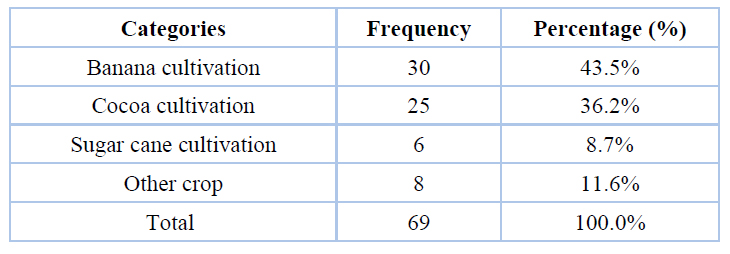
Table 7. Frequency and percentages of the main crops (Source: Own elaboration)
The farms of the parish present intensive cultivation of bananas, cocoa and sugar cane, with percentages of 43.5; 36.2 and 8.7%; however, when dealing with family systems, other types of products can be found that are cultivated in a smaller proportion, or sometimes immersed in commercial crops, they are generally products for family consumption and represent 11.6% of the crops.
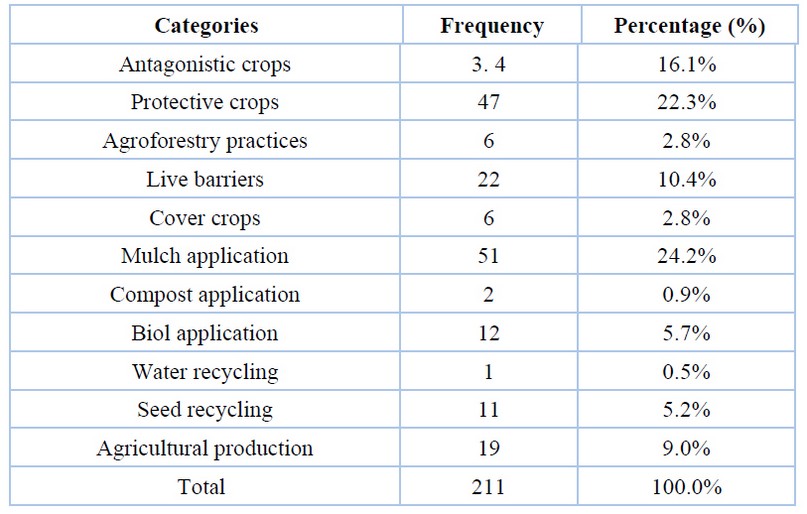
Table 8. Frequency and percentages of applied agro-ecological practices (Source: Own elaboration)
Of the 12 agro-ecological practices that were presented in the survey, all except one (crop rotation), had some degree of incidence in the agricultural production systems of the Mariscal Sucre parish. Therefore, this option is set aside for the analysis. The most frequent agro-ecological practices in the area consisted of the application of Mulch at 24.17%, then knowledge about the management of protective crops at 22.27%, followed by the administration of antagonistic crops at 16.11%.
Then, the practice of applying live barriers has a 10.43% incidence. Lastly, agricultural production with 9.01%, application of Biol with 5.69% and recycling of seeds with 5.21%. These practices have a medium frequency. Finally, the least frequent were knowledge about agroforestry practices and cover crops, with 2.84% each and Compost and water recycling, with 0.95 and 0.47%, respectively.
Determine the level of correlation that exists between the practices of traditional agricultural knowledge and the development of the agroecosystems of the Mariscal Sucre rural parish.
Sustainability analysis of productive systems.
To know the degree of sustainable development of the agricultural systems of the parish, a survey was applied to 61 farmers in the area; then the data was processed in an Excel matrix that can be viewed in the annexes to evaluate the degree of sustainability it was necessary to establish the average of the 61 respondents for each of the sustainability indicators that make up the three dimensions of agro-ecological development. The results are presented as radial graphs for each dimension.
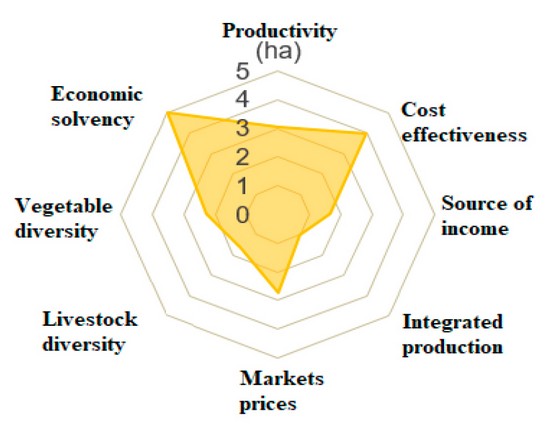
Figure 1. Economic Sustainability
From the economic dimension, the best score was that of economic solvency, since farmers rated their farms with an optimal value of 5, followed by profitability with a value of 4, then the productivity indicator with 3. The price indicators of market and plant diversity are around medium sustainability, with values of 2.7 and 2.3, respectively. The indicators of sources of economic income, livestock diversity and integrated production tend to agro-ecological unsustainability since their values were 1.7, 1.7 and 1, respectively.

Figure 2. Social Sustainability
The best-scored indicator was technical training, with a value of 3.1, followed by the indicator of access to education since the parish has at least one educational institution and the indicator of belonging to local groups or associations. of farmers, both scored with a value of 3, that is to say that the three indicators are around a medium degree of sustainability. The indicators of knowledge of traditional or ancestral agricultural practices, the type of labor used in the work of the farm and the degree of participation that family members can have in decision-making, with values of 1.9, 1.8 and 1.1, respectively, that is, they have unsustainability.
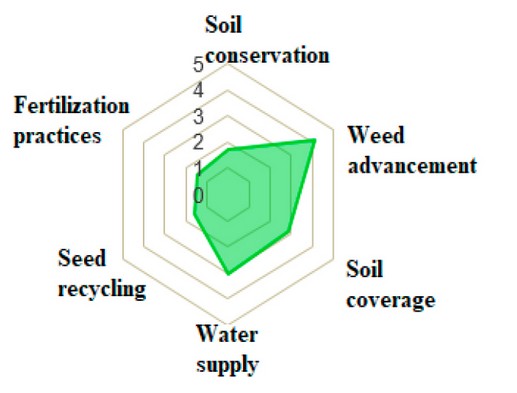
Figure 3. Environmental sustainability
The dimension of environmental sustainability is also made up of six indicators, of which the best score was the one that refers to the presence of weeds, with a value of 4.1 that tends to optimal sustainability, followed by the form of supply. of water, of the land cover practices applied, whose values were 3, and 2.9, that is, it is in a medium degree of sustainability, while the indicators referring to soil conservation practices, recycling of seedlings and seeds and fertilization practices presented values of 1.7; 1.6 and 1.5, that is, the latter are close to the degree of environmental unsustainability of agricultural production systems.
The agricultural systems of the Mariscal Sucre parish presented a better development in the economic dimension, followed by the environmental size and the social dimension, with values of 2.7, 2.5 and 2.3, respectively; that is, they are close to average sustainability. However, the degree of total sustainability of the productive systems is estimated by adding the individual performance of each indicator, thus, the average sustainability of the agricultural systems of the parish was 50%, considered as agro-ecological unsustainability; however, 3 of the 61 agroecosystems presented values of 60 to 62 %, which would indicate a medium agro-ecological sustainability (see annexes).

Figure 4. Performance for each dimension
Analysis of the instrument’s reliability.
The internal consistency statistic coefficient of Cronbach’s Alpha was used to determine the reliability of the evaluation instrument (survey).
The index can take values from zero to one so that its assessment scale is distributed as: unreliable (<0.7), acceptable reliability (0.7 to 0.90) and redundancy or duplication (>0.90 to 1). Where a value of 0.80 would indicate the optimal reliability of the instrument.
The test was run in SPSS software, for which the database was exported from an Excel file; the data was normalized and refined, considering that it is a mixed form and the first section contains classification data. While of the sections corresponding to the dimensions: economic, social and environmental, Of the 20 evaluation items, 10 were excluded because their variables did not correspond to scalar or ordinal variables, and the particular cases were not discriminating enough, however. In the end, they were helpful in determining the degree of sustainability of agricultural systems.
Cronbach’s alpha value of 0.72 indicated that the instrument was reliable enough to collect consistent information regarding the development of agricultural systems in the rural parish of Mariscal Sucre.

Table 9. Reliability by Cronbach ‘s alpha
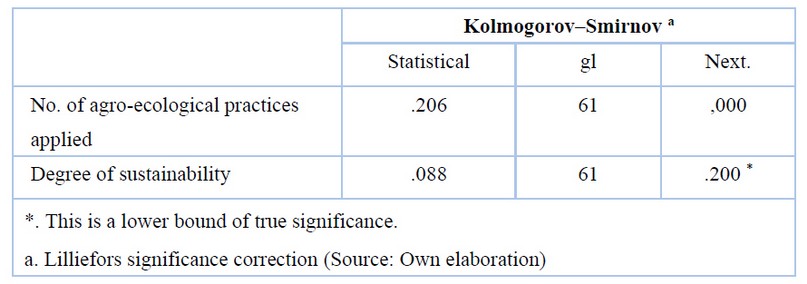
Table 10. Normality tests
Before choosing the correlation statistic, the variables were analyzed to verify if they met the parametric or nonparametric statistics criteria.
The two variables come from independent samples; they are of the ratio scale type; however, only the variable: degree of sustainability, presented a significance > 0.05; complying with the normality criterion, so it is decided to use the statistic, Spearman’s Rho[2] of nonparametric statistics.
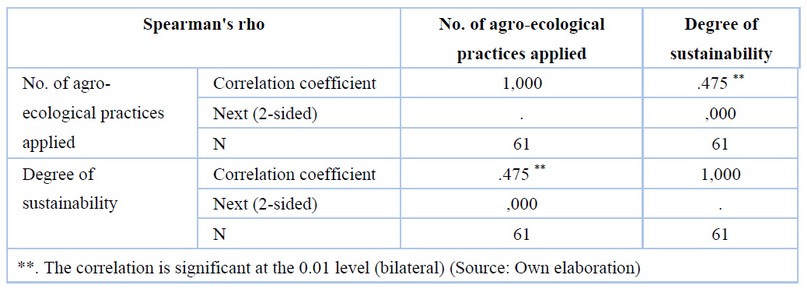
Table 11. Nonparametric bivariate correlations.
The variables present a moderate positive correlation index of 0.48 and a statistical significance of less than 0.05 (p-value < 0.05), so the null hypothesis is rejected, and the alternative is accepted, which maintains that the Traditional agricultural knowledge practices have a favorable impact on the sustainable development of agroecosystems in the rural parish of Mariscal Sucre.
Simple dispersion of the degree of sustainability by applied agro-ecological practices.
In the scattergram, it can be seen that the points have an increasing linear relationship.

Figure 5. Correlation between agro-ecological practices and the degree of sustainability
DISCUSSION
The research started from the need to know how agro-ecological sustainable the agricultural systems of the Mariscal Sucre parish, which belongs to the Milagro Canton.
A wide range of analysis methodologies was found, some that were developed more than two decades ago, and others more current, which are the result of the modification that the previous ones have suffered. For this reason, the document presented those that were applied. More frequently in Latin American countries. These methodologies were: IICA, SAFE, FESLM, MESMIS and REDAGRES; without a doubt, the one that presented the most significant number of cases was MESMIS. They promote these methodologies’ ease of application; by sharing the same methodological framework, they assess the degree of sustainability through indicators. 9
The method chosen to evaluate the degree of sustainability of the agricultural systems in this study was MESMIS; there were a total of 20 indicators related to the indicators designed by Albarracín, although these were duly adapted to the local context 10. Similarly, Fonseca’s research was considered by including the REDAGRES traffic light classification in the presentation of the results 11. The sustainability indices calculated for the 61 farmers yielded values from 40 to 62% with an average of 50%, being classified as unsustainable; on the other hand, the agroecosystems analyzed by Albarracín had indices of 62 to 76%, that is, they were classified as unsustainable. as moderately sustainable. In the parish, only three systems presented indexes of 60 to 62%, barely meeting the minimum values of average sustainability. 12
The most frequent agro-ecological practices corresponded to knowledge about the existence of protective, antagonistic crops and the application of Mulch as soil cover, the others were applied little, and even crop rotation was non-existent. The correlation between these practices and the degree of agro-ecological development was moderately positive, with a Spearman’s Rho correlation index value of 0.48, which leads to the rejection of the null hypothesis and the acceptance of the alternative hypothesis, which indicates that the implementation of Traditional agricultural knowledge practices has a favorable impact on the sustainable development of agroecosystems in the rural parish of Mariscal Sucre. On the other hand, the farms’ development is mostly influenced by the economic component; therefore, it cannot be assumed that there is direct causality between the variables.
Lodana experimental center of the Universidad Laica Eloy Alfaro de Manabí 13; and the second, carried out in the Río Negro Sopladora National Park in Azuay, proposes the implementation of livestock production of minor species and the production of organic fertilizers from agricultural residues 14. The authors state that these strategies can almost immediately affect farm productivity and therefore take another step toward the country’s ecological transition. For these reasons, the agro-ecological management proposal was raised from the productive dimension, including some practices of traditional knowledge, both in the agricultural and livestock components.
CONCLUSIONS
It was determined that traditional agricultural knowledge practices favorably influence the development of banana, cocoa and sugar cane crops established in the rural parish of Mariscal Sucre, finding a value of 0.48 for the Spearman’s Rho statistic, indicating that there is a moderate positive correlation between these variables.
An agro-ecological management proposal was established to promote the development of banana, cocoa and sugarcane crops through implementing practices for raising minor species, polycultures and the production of organic fertilizers from farm residues. To diversify the agricultural production system and boost the efficiency of the farms.
Conflicts of Interest: The authors declare no conflict of interest
REFERENCES
1. Food and Agriculture Organization of the United Nations. The State of Food and Agriculture. 38th ed. Rome: FAO Collection:; 2007.
2. Madrid A. Organic agriculture and traditional agriculture: an intercultural alternative.. Revista Flacso Andes. 2009; 844.
3. León X. Transgenics, agribusiness and food sovereignty. Revista Flacso Andes. 2014;(1235).
4. Tamayo A. Organic agriculture and traditional agriculture: an intercultural alternative. Revista Flacso Andes. 2013;(4).
5. Santamaría L, O. R. Evaluation of agroecosystems through sustainability indicators in san josé de las lajas, province of mayabeque, Cuba. SciELO Analytics. 2017;(44).
6. Cevallos M, Urdaneta F, Jaimes E. Development of agro-ecological production systems: Dimensions and indicators for their study.. Journal of Social Sciences (Ve). 2019;(3).
7. Cevallos M, Urdaneta Fátima , Jaimes E. Development of agro-ecological production systems: Dimensions and indicators for their study. Journal of Social Sciences (Ve). 2019;(3).
8. Saavedra M. Methodologies for obtaining indicators of agro-ecological sustainability in organic vineyards (Graduation work (Grade), UNIVERSIDAD DE CHILE). Universidad de Chile; 2015.
9. Saavedra M. Methodologies for obtaining indicators of agro-ecological sustainability in organic vineyards (Graduation work (Grade), UNIVERSIDAD DE CHILE).. [Online].; 2015. Available from: HYPERLINK «https://repositorio.uchile.» https://repositorio.uchile.
10. Albarracín J, Fonseca N, López L. Agroecological practices as a contribution to the sustainability of agroecosystems. Science and Agriculture Magazine. 2019; 16(2).
11. Fonseca N, Vega Z. proposal of indicators to evaluate sustainability in agricultural and livestock agroecosystems in the sumapaz region.. Pensamiento Udecino. 2018; 2(1).
12. Albarracin J, Fonseca N, López L. Agroecological practices as a contribution to the sustainability of agroecosystems. Sumapaz province case. Science and Agriculture. 2019; 16(2).
13. Ávila E, Granda V. University Laica Eloy Alfaro de Manabi Faculty of Agricultural Sciences. [Online].; 2018. Available from: HYPERLINK «https://1library.co/document/zw3lvmgy-universidad-laica-eloy-alfaro-manabi-facultad-ciencias-agropecuarias.html» https://1library.co/document/zw3lvmgy-universidad-laica-eloy-alfaro-manabi-facultad-ciencias-agropecuarias.html .
14. Jadán A. Universidad Polytechnic Salesiana sede Cuenca. [Online].; 2020. Available from: HYPERLINK «https://dspace.ups.edu.ec/bitstream/123456789/18716/1/UPS-CT008760.pdf» https://dspace.ups.edu.ec/bitstream/123456789/18716/1/UPS-CT008760.pdf .
Received: 26 September 2022 / Accepted: 15 October 2022 / Published:15 February 2023
Citation: Salazar E J, Guerrero M J, Villaquiran J A, Suárez K S, Cevallos J M. Development of enhanced primer sets for detection of Norovirus and Hepatitis A in food samples from Guayaquil (Ecuador) by reverse transcriptase-heminested PCR. Revis Bionatura 2023;8 (1) 3. http://dx.doi.org/10.21931/RB/2023.08.01.3






















